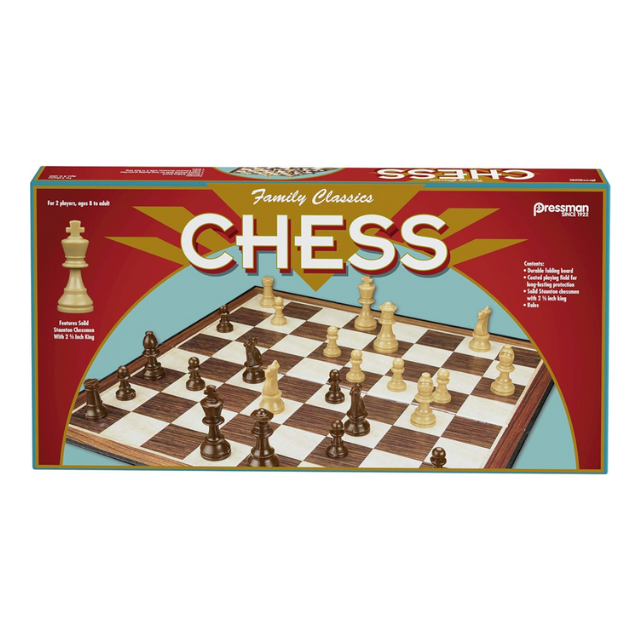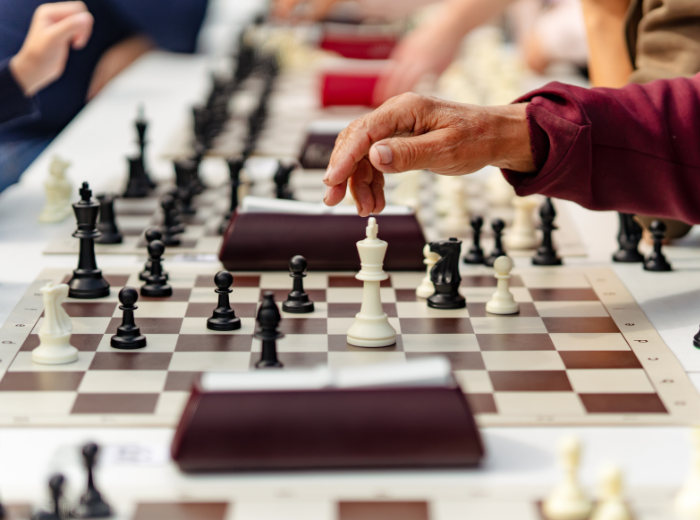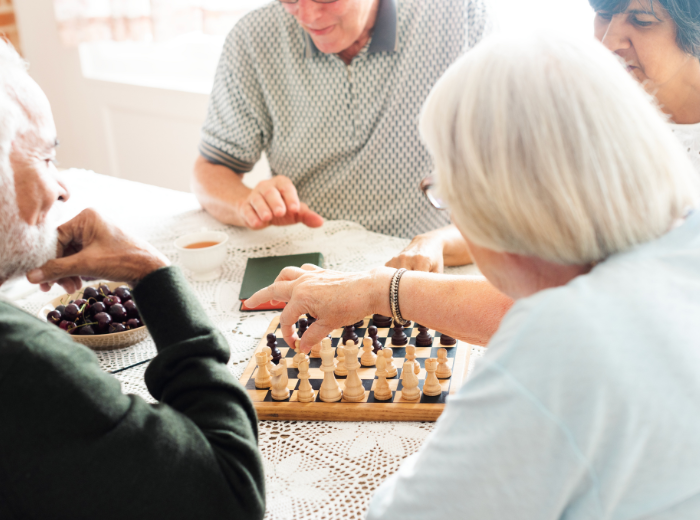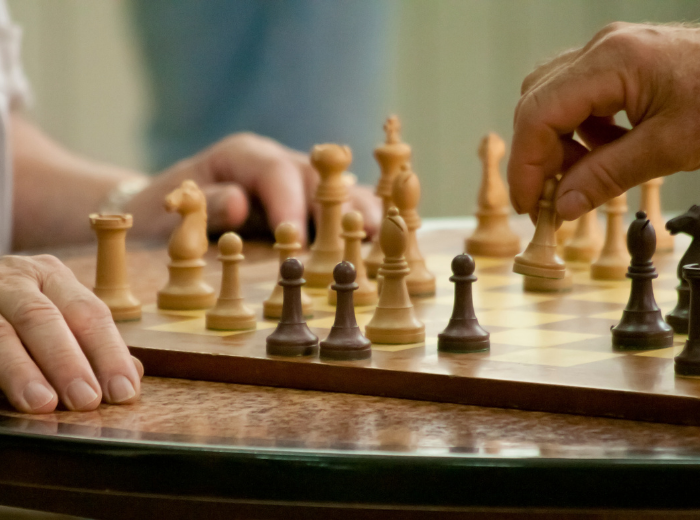


Our Products
Dementia-Friendly Chess Game for Seniors and Caregivers
Dementia-Friendly Chess Game for Seniors and Caregivers
Couldn't load pickup availability
Chess is a timeless game that can be adapted for individuals with dementia in the early and middle stages, and thoughtfully modified for those in the late stage. This dementia-friendly chess set encourages cognitive stimulation, memory support, and meaningful engagement. Customizing the experience to fit individual cognitive and physical needs is key to ensuring accessibility, comfort, and enjoyment.
*All pictures shown are for illustration purpose only. Actual product may vary.
Products available through Always Home Connected are sold for adult use and are not intended for use by children.
Product Size
Product Size
A standard dementia-friendly chessboard
typically measures around 12 inches by 12 inches. Chess pieces vary, with the king measuring 2 to 2.5 inches tall — ideal for easy handling and visibility.
Material
Material
Durable folding board
Coated playing field for long lasting protection
Solid Staunton chessmen with 2-1/2 inch King
Rules
Benefits
Benefits
Cognitive Stimulation for Dementia: Chess strengthens memory, strategic thinking, planning, and focus, offering mental exercise critical for maintaining cognitive abilities.
Social Engagement for Seniors: Playing chess encourages communication, companionship, and shared activities between individuals with dementia, family members, and caregivers.
Visual and Tactile Stimulation: The colorful and tactile tiles provide sensory stimulation and engagement.
Entertainment: The game offers entertainment and enjoyment, reducing stress and anxiety while promoting a sense of accomplishment upon winning.
Delivery Info
Delivery Info
Delivery times and costs depend where you live, when purchased and if in-stock.
Relevance to Dementia Stage
Relevance to Dementia Stage
Early Stage Dementia: Ideal for seniors or individuals newly diagnosed with Alzheimer’s or dementia, maintaining cognitive skills through classic gameplay.
Middle Stage Dementia: Simplified chess rules, visual aids, or guided play can help maintain engagement, foster connection, andoffer a therapeutic outlet.
Late Stage Dementia: Symbolic play or adapted sets focusing on familiar routines and sensory engagement offer comfort, reduce isolation, and support quality of life.




Chess Board Game
Welcome to the world of chess! Whether you're a seasoned player or a beginner,
this timeless and strategic game offers an enjoyable and stimulating experience
suitable for individuals of all ages.

What Is a Chess Game Board?
Chess is a two-player strategy game played on a checkered board consisting of 64 squares arranged in an 8x8 grid.
The objective of the game is for each player to strategically move a variety of pieces — including pawns, rooks, knights, bishops, a queen, and a
king — across the board, with the ultimate goal of putting the opponent’s king into checkmate and claiming victory.

How to Play Chess
Get ready for some chessboard fun! Here's a breakdown of how to play:
Setting Up:
- Use a chessboard with 64 squares (alternating dark and light squares).
- Each player sets up 16 pieces: one king, one queen, two rooks, two knights, two bishops, and eight pawns.
- Arrange the pieces so that each player has a light-colored square on their right-hand side ("white on right").
- The second row is filled with pawns; the major pieces go on the first row in the order (left to right): rook, knight, bishop, queen (on her own color), king, bishop, knight, rook.
- The player with the white pieces always moves first.

Making Moves: Players take turns moving one piece at a time.
Each type of piece moves in a specific way:
- Pawns move forward one square (or two squares on their first move) and capture diagonally.
- Rooks move any number of squares vertically or horizontally.
- Knights move in an L-shape: two squares in one direction and then one square perpendicular.
- Bishops move any number of squares diagonally.
- Queen can move any number of squares vertically, horizontally, or diagonally.
- King moves one square in any direction.

Capturing Pieces:
To capture an opponent’s piece, move your piece onto the square occupied by their piece, removing it from the board.
Special Moves:
Castling: A move involving the king and one rook to help protect the king.
En Passant: A special pawn capture under certain conditions.
Promotion: When a pawn reaches the opponent’s back row, it can be promoted to a queen,
rook, bishop, or knight.

Winning the Game:
The goal is to checkmate your opponent’s king — putting it under threat of capture with no legal moves to escape.
A game can also end in a draw under certain conditions (like stalemate or insufficient material).

Chess Board Game Rules
Here's a brief overview of the fundamental chess board game rules:
- In chess, players take turns, moving one piece per turn.
- Each type of piece moves in its own special way:
Pawns move forward one square (or two squares on their first move) and capture diagonally.
Rooks move any number of squares straight across rows or columns.
Knights move in an L-shape — two squares in one direction, then one square sideways.
Bishops move any number of squares diagonally.
The Queen can move any number of squares in any direction — straight or diagonal.
The King moves one square in any direction.

- To capture an opponent's piece, move your piece onto the square where their piece is located, removing it from the board.
- The primary goal is to put your opponent’s king in "checkmate" — trapping the king so it cannot escape capture.
- If your king is in "check" (threatened with capture), you must move to protect it.
- Special moves like castling (moving the king and rook at the same time) and pawn promotion (turning a pawn into a queen or other piece) can happen under
certain conditions.

The Benefits of Board Games with Chess for Dementia Patients
Research has shown that engaging in board games such as chess can offer significant benefits to individuals living with dementia. The cognitive stimulation gained from planning moves, anticipating opponents’ strategies, and making tactical decisions can help support memory, concentration, and overall cognitive function.
In addition, the social interaction and active participation that come from playing chess can foster a sense of connection, belonging, and purpose — all of which are vital to emotional well-being! And most importantly, the focus should always be on having fun and enjoying the shared experience of the game.
FAQ
Can dementia patients play chess?
Yes, individuals living with dementia can enjoy playing chess, especially if they have experience with the game. Modified or simplified versions of chess can offer meaningful engagement, stimulate memory, and provide social connection.
How do you play chess for adults?
Chess for adults follows traditional rules, but games can be adapted based on skill level. Adults often enjoy casual matches,
learning strategies, and focusing on the social and cognitive benefits of play rather than strict competition.
Is chess good for the brain?
Absolutely! Chess strengthens memory, problem-solving skills, concentration, and critical thinking. Studies show it can help delay cognitive decline and promote brain health across all ages.
Is chess hard?
Chess can be challenging to master, but it’s easy to learn the basics. With practice, players of all ages and skill levels can enjoy the game, whether casually or competitively.
Is chess a game for adults?
Yes, chess is a timeless game enjoyed by adults around the world. It offers both mental stimulation and social engagement, making it a popular choice for lifelong learning and recreation.


